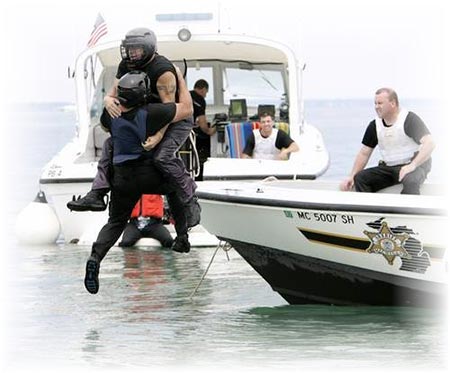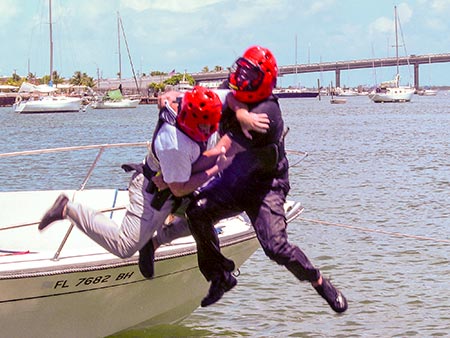Contact Us
To provide feedback on the Community Policing Dispatch, e-mail the editorial board at CPDispatch@usdoj.gov.
To obtain details on COPS Office programs, publications, and resources, contact the COPS Office Response Center at 800-421-6770 or AskCopsRC@usdoj.gov

U.S. Department of Justice
Office of Community Oriented Policing Services
Washington, DC 20530
Though law enforcement officers are trained in almost every aspect of their jobs, from report writing to pursuit driving, few are trained in water safety. A number of departments have highly skilled marine units, but not many train their patrol officers. Even so, it is not unusual for an officer to rescue a person from the water, get caught in a swamped patrol car, or fall when boarding or pulling something out of a boat.
In the past five years, 15 officers have died from drowning. And according to Glenn Wilson, lead water safety instructor at RAD Training, Inc. of Largo, Florida, there may be uncounted others who have lost their lives due to secondary drowning, a condition which occurs hours or even days after a near-drowning experience, when small amounts of water in the lungs cause a fatal drop in blood oxygen levels. Still others may have had heart attacks caused by the stress of their experience.
 It can happen anywhere
It can happen anywhere
Major floods have swept over large areas of our country this year, threatening the lives of entire communities. But even small floods from heavy rains can take a life, as happened in Kentucky in 2018. An officer patrolling in his squad car saw water on the road but did not realize how deep it was. Soon after he entered the water, the car sank. Though he escaped and climbed onto the roof, he jumped into the water and drowned. A similar incident happened in Houston in 2017.
That same year, Ohio County (West Virginia) Corporal Richard White III responded to a call for service regarding several people caught in the swift and dangerous waters of Wheeling Creek. Entering the heavy current repeatedly, he managed to save a 13-year-old girl and an adult woman caught in the undertow. For his heroism, he won the Attorney General’s Award for Distinguished Service in Policing.
Corporal White attributes his ability to carry out this rescue to growing up as a swimmer and being comfortable in the water, as well as his water-based training in the Army, which was standard for all recruits. And today the Ohio County Sheriff’s Office requires all applicants to pass a water fitness exam requiring them to tread water for two minutes and swim a lap in a local pool.
A low-frequency but high-risk danger
Says Gulf Shores (Alabama) Police Chief Ed Delmore, “No matter where you are, there is always the possibility of ending up in the water, especially with floods happening around the country with some regularity. Though the danger may be low frequency for some departments, it’s always a high-risk situation. Every officer should be prepared.”
Dave Young, a water survival training expert and co-founder of Vistelar, a law enforcement training organization in Milwaukee, Wisconsin, points out that “if you’re 5’8”and you fall into a 6’ deep pool, you’re in over your head. No matter where an officer works, being familiar with the water and your own abilities are essential to saving yourself as well as others.”
Iron ducks: Officers in waterlogged vests and utility belts
What’s more, many officers are not good swimmers. “We call them iron ducks,” says Young. “Some can’t even float or tread water, which in many circumstances is more important than swimming. And even the best of them can tire quickly when fully outfitted, which is fatal.”
Even if the officer is a good swimmer, struggling in freezing water wearing a fully loaded duty belt, vest and boots, which can weigh up to 30 pounds when water logged and also restrict movement, is a completely different scenario from recreational swimming. “What’s more,” says Young, “in a pool, you swim with your head in the water. In an open environment, you have to keep your head above the water to be sure you’re going in the right direction.
To enhance the safety of their officers, not only to survive an unexpected immersion but to fight an assailant in the water, some law enforcement agencies have begun water safety training programs. Among them is the Pennsylvania State Police Water Survival Training. In addition to life saving methods, the program teaches skills such as how to build stamina and maintain body heat in cold water, as well how to deal with an assailant in or near the water.
Water safety training designed for law enforcement
Similar skills are taught by specialized organizations such as Vistelar and RAD Training, Inc. which teach response, rescue and survival tactics. Participants swim, tread water, and go through other drills wearing body armor and a simulated duty belt. They also learn how to get their duty belts off quickly, protect their gun inside their vests or use the vest as a flotation device, and even how to remove their pants, fill them with air, tie the ends, and use them for flotation.
Once officers enter the water, they have seconds to get their duty belts off. “And if you’re pursuing a suspect, you have additional problems” says Young. “You can’t see his hands and swimming with a firearm will be very difficult.” Some programs teach officers how to deal with a struggle in the water through defensive tactics, evasion drills, and practice in handgun retention. But though they may also learn to shoot from or under the water, officers must follow the same firearms safety principles they do on land.
 Facing an assailant in the water
Facing an assailant in the water
“It’s also hard to know if the person is resisting arrest or drowning, even if he’s thrashing around. Stay alert to a possible ambush. He could be luring you in for an attack, hoping you’ll be at a disadvantage.” If you do go in, Young recommends keeping your distance and swimming parallel to, not behind, the individual. “Whether it’s an arrest or rescue operation, that person can panic, grab onto your head, and push you down,” he says.
Says Glenn Wilson, “We teach swimming with a handgun drawn and while scanning for threats. But the most important thing we teach is how to self-rescue. If you can’t save yourself, you’re no good to anybody else. And if you can’t tread water for long, you can’t combat an assailant, rescue anyone, or be easily rescued yourself.”
Tips from the experts
Though professional training is highly recommended, Dave Young and others say that officers can increase their water safety in several ways. This starts with assessing your skills and limits and getting well acquainted with the water in your area—its currents, temperature, depth, best entry points, bridge and dock locations, etc.
However, all agree that the best course of action in a rescue situation is to stay on land if possible, and find something you can extend to an individual flailing in the water. A number of police departments, including the Ohio County Sheriff’s Office where Corporal White works, equip their squad cars with water rescue throw bags, which contain about 70 feet of floatable, plastic rope attached to a bag that the person in danger can grab. But in an emergency, a hose or even a tree branch will do.
Rescuers can become victims
Moreover, it’s critical for officers to call in their exact location on the water and the nearest entry point so backup can find them. Officers are not always the best person for a water rescue; waiting for the arrival of a specially trained and equipped rescue team could offer the best chance of survival for all.
Says Young: “Many law enforcement drowning victims were attempting a rescue. If you do go in, stay calm and tread water while getting rid of your duty belt. Talk to the individual in distress to calm them too, but avoid physical contact—a drowning victim will try to use you as flotation. Instead, coax the individual to swim toward you as you back up in the water, encouraging them to make it to safety.”
Getting the training you need
Experts recommend that all patrol officers who work in areas with lakes, rivers, an ocean, or even a lot of swimming pools get water screening to test their limitations—and, if they need it, a waterproofing course to learn critical water safety skills. Glenn Wilson suggests that they assess themselves in local pools under supervision, find a swim stroke they can do comfortably, check their ability to float and control their breathing, and practice swimming under water.
Officers can take swimming lessons through local organizations if they need them. The Red Cross also offers swimming, water safety, and lifeguarding courses, which can enable officers to become training resources within their own department. Departments may also be eligible for training grants and, by training some of their officers, develop their own water screening programs.
Faye Elkins
Senior Technical Writer
Sources for More Information
American Red Cross
Pennsylvania State Police Water Survival Course
Subscribe to Email Updates
To sign up for monthly updates or to access your subscriber preferences, please enter your email address in the Subscribe box.






